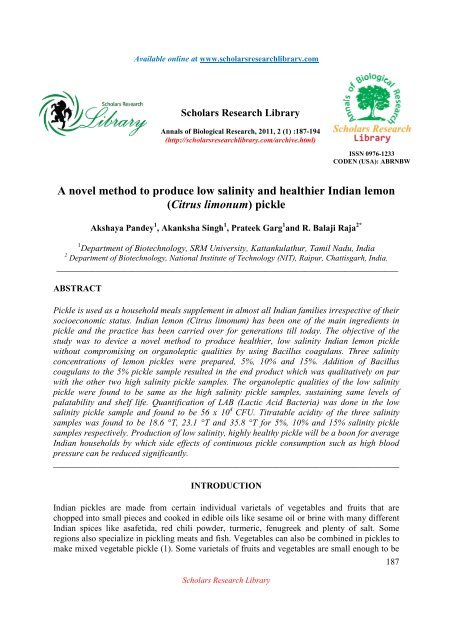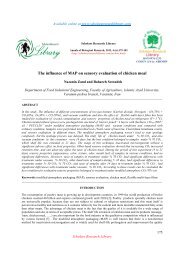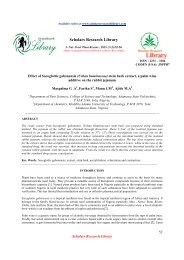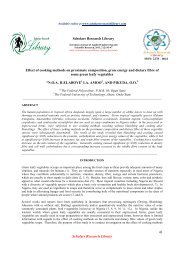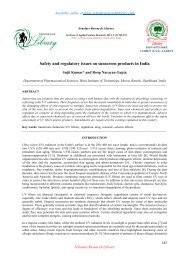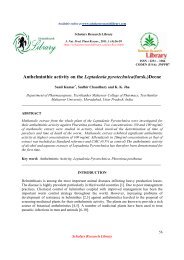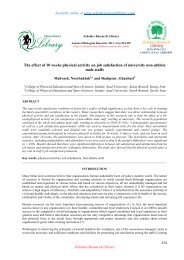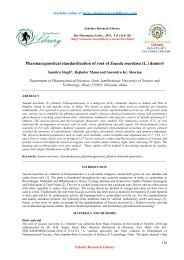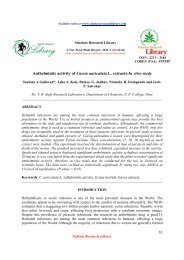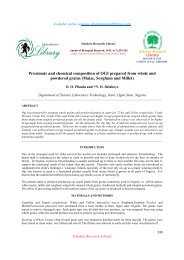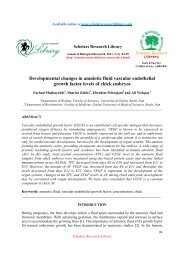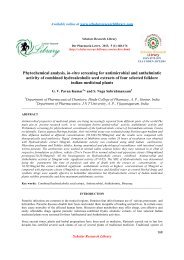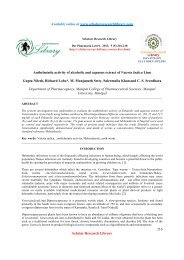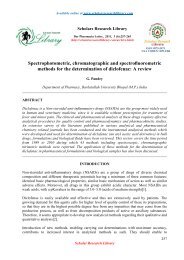A novel method to produce low salinity and - Scholars Research ...
A novel method to produce low salinity and - Scholars Research ...
A novel method to produce low salinity and - Scholars Research ...
You also want an ePaper? Increase the reach of your titles
YUMPU automatically turns print PDFs into web optimized ePapers that Google loves.
Available online at www.scholarsresearchlibrary.com<br />
<strong>Scholars</strong> <strong>Research</strong> Library<br />
Annals of Biological <strong>Research</strong>, 2011, 2 (1) :187-194<br />
(http://scholarsresearchlibrary.com/archive.html)<br />
ISSN 0976-1233<br />
CODEN (USA): ABRNBW<br />
A <strong>novel</strong> <strong>method</strong> <strong>to</strong> <strong>produce</strong> <strong>low</strong> <strong>salinity</strong> <strong>and</strong> healthier Indian lemon<br />
(Citrus limonum) pickle<br />
Akshaya P<strong>and</strong>ey 1 , Akanksha Singh 1 , Prateek Garg 1 <strong>and</strong> R. Balaji Raja 2*<br />
1 Department of Biotechnology, SRM University, Kattankulathur, Tamil Nadu, India<br />
2 Department of Biotechnology, National Institute of Technology (NIT), Raipur, Chattisgarh, India.<br />
_____________________________________________________________________________<br />
ABSTRACT<br />
Pickle is used as a household meals supplement in almost all Indian families irrespective of their<br />
socioeconomic status. Indian lemon (Citrus limonum) has been one of the main ingredients in<br />
pickle <strong>and</strong> the practice has been carried over for generations till <strong>to</strong>day. The objective of the<br />
study was <strong>to</strong> device a <strong>novel</strong> <strong>method</strong> <strong>to</strong> <strong>produce</strong> healthier, <strong>low</strong> <strong>salinity</strong> Indian lemon pickle<br />
without compromising on organoleptic qualities by using Bacillus coagulans. Three <strong>salinity</strong><br />
concentrations of lemon pickles were prepared, 5%, 10% <strong>and</strong> 15%. Addition of Bacillus<br />
coagulans <strong>to</strong> the 5% pickle sample resulted in the end product which was qualitatively on par<br />
with the other two high <strong>salinity</strong> pickle samples. The organoleptic qualities of the <strong>low</strong> <strong>salinity</strong><br />
pickle were found <strong>to</strong> be same as the high <strong>salinity</strong> pickle samples, sustaining same levels of<br />
palatability <strong>and</strong> shelf life. Quantification of LAB (Lactic Acid Bacteria) was done in the <strong>low</strong><br />
<strong>salinity</strong> pickle sample <strong>and</strong> found <strong>to</strong> be 56 x 10 4 CFU. Titratable acidity of the three <strong>salinity</strong><br />
samples was found <strong>to</strong> be 18.6 °T, 23.1 °T <strong>and</strong> 35.8 °T for 5%, 10% <strong>and</strong> 15% <strong>salinity</strong> pickle<br />
samples respectively. Production of <strong>low</strong> <strong>salinity</strong>, highly healthy pickle will be a boon for average<br />
Indian households by which side effects of continuous pickle consumption such as high blood<br />
pressure can be reduced significantly.<br />
______________________________________________________________________________<br />
INTRODUCTION<br />
Indian pickles are made from certain individual varietals of vegetables <strong>and</strong> fruits that are<br />
chopped in<strong>to</strong> small pieces <strong>and</strong> cooked in edible oils like sesame oil or brine with many different<br />
Indian spices like asafetida, red chili powder, turmeric, fenugreek <strong>and</strong> plenty of salt. Some<br />
regions also specialize in pickling meats <strong>and</strong> fish. Vegetables can also be combined in pickles <strong>to</strong><br />
make mixed vegetable pickle (1). Some varietals of fruits <strong>and</strong> vegetables are small enough <strong>to</strong> be<br />
<strong>Scholars</strong> <strong>Research</strong> Library<br />
187
R. Balaji Raja et al Annals of Biological <strong>Research</strong>, 2011, 2 (1): 187-194<br />
_____________________________________________________________________________<br />
used whole. The most common Indian-style pickles are made from mango <strong>and</strong> lime. Others<br />
include caulif<strong>low</strong>er, carrot, radish, <strong>to</strong>ma<strong>to</strong>, onion, pumpkin, palm heart, lotus stem, rose petals,<br />
ginger, Indian gooseberry, garlic, green or red chili peppers, kohlrabi, gunda, kerda, zimik<strong>and</strong><br />
(purple yam), karonda, karela (bitter melon), jackfruit, mushroom, eggplant, cucumber <strong>and</strong><br />
turnip as suggested by Gorbach et al (4). Homemade pickles are prepared in the summer <strong>and</strong><br />
kept in the sun during daytime while s<strong>to</strong>red in porcelain or glass jars with airtight lids. The high<br />
concentrations of salt, oil <strong>and</strong> spices act as preservatives. Many commercially <strong>produce</strong>d pickles<br />
use preservatives like citric acid <strong>and</strong> sodium benzoate. Even using the same main ingredients,<br />
Indian pickles come in a wide variety of flavors due <strong>to</strong> differences in spices <strong>and</strong> process (3). A<br />
mango pickle from South India may taste very different from one made in North India. In the<br />
southern states, sesame oil is preferred, while mustard oil is preferred in northern states for<br />
making pickles (7).<br />
Lime is one of the most common ingredient for preparing pickle. In cooking, lime is valued both<br />
for the acidity of its juice <strong>and</strong> the floral aroma of its zest. It is a very common ingredient in<br />
authentic Mexican, Southwestern United States, Vietnamese <strong>and</strong> Thai dishes. It is also used for<br />
its pickling properties in ceviche. The use of dried limes (called black lime or loomi) as a<br />
flavouring is typical of Persian cuisine <strong>and</strong> Iraqi cuisine, as well as in Gulf-style baharat (a spice<br />
mixture that is also called kabsa or kebsa). Lime is an essential ingredient of any cuisine from<br />
India <strong>and</strong> many varieties of pickles are made e.g. Sweetened lime pickle, salted pickle, Lemon<br />
Chutney. Lime leaves are also a herb in South, East, <strong>and</strong> Southeast Asia.<br />
Bacillus coagulans is a lactic acid forming bacterial species within the genus Bacillus. The<br />
organism was first isolated <strong>and</strong> described in 1932 <strong>and</strong> was elaborated in the fifth edition of<br />
Bergey's Manual of Determinative Bacteriology. It was initially considered <strong>to</strong> be a spore-forming<br />
Lac<strong>to</strong>bacillus. Since Bacillus coagulans exhibits characteristics typical of both genera<br />
Lac<strong>to</strong>bacillus <strong>and</strong> Bacillus, its taxonomic position between the families Lac<strong>to</strong>bacillaceae <strong>and</strong><br />
Bacillaceae was often debated. However, in the seventh edition of Bergey’s, it was finally<br />
transferred <strong>to</strong> the genus Bacillus. DNA-based technology was used in distinguishing between the<br />
two genera of bacteria which are morphologically similar <strong>and</strong> possess similar physiological <strong>and</strong><br />
biochemical characteristics.<br />
B. coagulans is a Gram-positive rod (0.9µm by 3.0µm <strong>to</strong> 5.0µm in size); catalase positive, sporeforming,<br />
motile, a facultative anaerobe. B. coagulans may appear Gram-negative when entering<br />
the stationary phase of growth according <strong>to</strong> Fujiwara et al (2). The optimum temperature for<br />
growth is 50 °C; range of temperatures <strong>to</strong>lerated is 30°C - 55°C. IMViC Tests VP <strong>and</strong> MR<br />
(methyl-red) tests are positive.<br />
Bacillus coagulans has been added by the EFSA <strong>to</strong> their Qualified Presumption of Safety (QPS)<br />
list <strong>and</strong> has been approved for veterinary purposes as GRAS by the U.S. Food <strong>and</strong> Drug<br />
Administration's Center for Veterinary Medicine, as well as by the European Union <strong>and</strong> is listed<br />
by AAFCO for use as a direct feed microbial in lives<strong>to</strong>ck production (10). Its main use is thus its<br />
veterinary applications, especially as a probiotic in pigs <strong>and</strong> shrimp. There are also references <strong>to</strong><br />
use of this bacterium in humans, especially in improving the vaginal flora, improving abdominal<br />
pain <strong>and</strong> bloating in Irritable Bowel Syndrome patients <strong>and</strong> increasing immune response <strong>to</strong> viral<br />
challenges. The bacterium has also been assessed for safety as a food ingredient. Spores are<br />
<strong>Scholars</strong> <strong>Research</strong> Library<br />
188
R. Balaji Raja et al Annals of Biological <strong>Research</strong>, 2011, 2 (1): 187-194<br />
_____________________________________________________________________________<br />
activated in the acidic environment of the s<strong>to</strong>mach <strong>and</strong> begin germinating <strong>and</strong> proliferating in the<br />
intestine.<br />
Pickles are restricted in various households because of their nature <strong>to</strong> increase the blood<br />
pressure. The high salt content in all varieties of pickle tends <strong>to</strong> push up the blood pressure when<br />
the consumer has a prolonged consumption of it. Pickles of different varieties have different<br />
levels of salt concentration in them <strong>and</strong> they are not uniform in nature. Although the<br />
concentration of NaCl (Sodium Chloride) can differ in the pickle varieties, the continuous<br />
consumption is not recommended in any case (9). The presence of Sodium Chloride in the pickle<br />
makes the elderly people more vulnerable <strong>to</strong> hyper blood pressure. The relationship between age<br />
<strong>and</strong> blood pressure is directly proportional, i.e. blood pressure increases with the increasing age<br />
(5). Advancement of age <strong>produce</strong>s less rigid blood vessels which results in increase of blood<br />
pressure. In these cases, continuous intake of pickle varieties which are rich in Sodium Chloride<br />
will surely be counterproductive.<br />
MATERIALS AND METHODS<br />
Pickle preparation<br />
Lemon fruits that had <strong>to</strong> be used for pickle preparation were procured from Guduvancherry, a<br />
locality near SRM University, Chennai. The lemons were ripe, dark yel<strong>low</strong> in colour <strong>and</strong> without<br />
any microbial or insect infections. Procured lemon fruits were washed with running water <strong>and</strong><br />
then with distilled water. The lemon fruits were then cut in <strong>to</strong> smaller pieces using a presterilized<br />
knife <strong>and</strong> placed in a container. About 300 grams of the cut lemon pieces were divided<br />
in <strong>to</strong> 3 equal portions with each having 100 grams weight. Each portion was added with different<br />
salt concentrations, 5%, 10%, <strong>and</strong> 15% respectively. The additional ingredients such as red chili<br />
powder <strong>and</strong> sesame oil were added in same proportion <strong>to</strong> all the three salt concentration pickle<br />
samples (acidify.htm).<br />
Addition of bacteria<br />
The bacteria had been procured from IMTECH (Institute of Microbial Technology), Ch<strong>and</strong>igarh,<br />
India, (MTCC number – 492). The bacterial species had been obtained in an active slant <strong>and</strong> was<br />
sub-cultured with Nutrient agar media before being used. After the pickle ingredients were added<br />
in <strong>to</strong> the container, Loopful of Bacillus coagulans (8 x 10 4 CFU) was added <strong>to</strong> the sample<br />
containing least <strong>salinity</strong> concentration, i.e. 5%. The uniformity of bacterial addition was<br />
maintained so that the results correspond in an acceptable way.<br />
Pickle end product<br />
The pickle mixture along with the above mentioned ingredients was al<strong>low</strong>ed <strong>to</strong> remain in shade<br />
for 10 days. The pickle samples were maintained at room temperature away from direct sun<br />
light. Occasional stirring was done <strong>to</strong> ensure that the blending had been perfect. A lot of<br />
emphasis was laid on blending as it is concerned with mixing of the pickle ingredients <strong>and</strong> the<br />
interaction between Bacillus coagulans, pickle.<br />
Assessment of fermentation effect by bacteria<br />
After 10 days are over, the three pickle samples of varying <strong>salinity</strong> concentrations were assessed<br />
for the comparative effect of bacterial fermentation. In the time period of ten days, the pickle<br />
<strong>Scholars</strong> <strong>Research</strong> Library<br />
189
R. Balaji Raja et al Annals of Biological <strong>Research</strong>, 2011, 2 (1): 187-194<br />
_____________________________________________________________________________<br />
formation was complete <strong>and</strong> it was fit for consumption. The least <strong>salinity</strong> concentration, 5% was<br />
assessed for the fermentative effect by Bacillus coagulans.<br />
Quantification of LAB (Lactic Acid producing Bacteria) <strong>and</strong> titratable acidity<br />
The LAB (Lactic Acid producing Bacteria) was quantified in the the least <strong>salinity</strong> concentration,<br />
5%. The titratable acidity of all the three pickle samples with varying <strong>salinity</strong> was determined in<br />
triplicate titrimetrically by using 0.1 M NaOH with phenolphthalein as an indica<strong>to</strong>r. The volume<br />
of the phenolphthalein used up in milliliters <strong>to</strong> neutralize the 0.1M NaOH of the acid in 10 ml of<br />
the product expressed in Toerner’s degree (ºT)<br />
Assessment of organoleptic characteristics<br />
After the pickle formation <strong>and</strong> quantification of bacteria, titratable acidity the various<br />
organoleptic characteristics were assesses for all three <strong>salinity</strong> samples. Organoleptic characters<br />
that were assessed were colour, flavour, taste, consistency <strong>and</strong> <strong>salinity</strong>.<br />
RESULTS<br />
The pickle formation was complete <strong>and</strong> flawless in all the three different <strong>salinity</strong> concentrations.<br />
The Quantification of LAB (Lactic Acid Bacteria) was done in the <strong>low</strong> <strong>salinity</strong> pickle sample,<br />
5% <strong>and</strong> found <strong>to</strong> be 56 x 10 4 CFU.<br />
Figure 1. Pickle samples during 1 st day of preparation (in ascending order of <strong>salinity</strong>)<br />
Titratable acidity of the three <strong>salinity</strong> samples was found <strong>to</strong> be 18.6 °T, 23.1 °T <strong>and</strong> 35.8 °T for<br />
5%, 10% <strong>and</strong> 15% <strong>salinity</strong> pickle samples respectively.<br />
<strong>Scholars</strong> <strong>Research</strong> Library<br />
190
R. Balaji Raja et al Annals of Biological <strong>Research</strong>, 2011, 2 (1): 187-194<br />
_____________________________________________________________________________<br />
Figure 2. Pickle samples after 10 days (in ascending order of <strong>salinity</strong>)<br />
The organoleptic characteristics of least <strong>salinity</strong> sample, 5% was found <strong>to</strong> be on par with the<br />
higher <strong>salinity</strong> pickle samples. The colour of the pickle was pale yel<strong>low</strong>, flavour was<br />
characteristic lime, taste was limited sourness, consistency was slightly viscous <strong>and</strong> <strong>salinity</strong> was<br />
just enough for palatability.<br />
Figure 3. 5% Salinity concentration sample at the end of 10 days<br />
191<br />
<strong>Scholars</strong> <strong>Research</strong> Library
R. Balaji Raja et al Annals of Biological <strong>Research</strong>, 2011, 2 (1): 187-194<br />
_____________________________________________________________________________<br />
The organoleptic characteristics of least <strong>salinity</strong> sample, 10% was found <strong>to</strong> be quite close with<br />
the 5% <strong>and</strong> 15% <strong>salinity</strong> pickle samples. The colour of the pickle was yel<strong>low</strong>ish, flavour was<br />
characteristic lime, taste was limited sourness, consistency was viscous <strong>and</strong> <strong>salinity</strong> was just<br />
enough for palatability.<br />
Figure 4. 10% Salinity concentration sample at the end of 10 days<br />
Figure 5. 15% Salinity concentration sample at the end of 10 days<br />
<strong>Scholars</strong> <strong>Research</strong> Library<br />
192
R. Balaji Raja et al Annals of Biological <strong>Research</strong>, 2011, 2 (1): 187-194<br />
_____________________________________________________________________________<br />
The organoleptic characteristics of least <strong>salinity</strong> sample, 15% was found <strong>to</strong> be in line with the<br />
5% <strong>and</strong> 10% <strong>salinity</strong> pickle samples. The colour of the pickle was yel<strong>low</strong>ish, flavour was<br />
characteristic lime, taste was sourness, consistency was more viscous <strong>and</strong> <strong>salinity</strong> was enough<br />
for palatability.<br />
DISCUSSION AND CONCLUSION<br />
Lemon pickles are usually preferred by many Indian families as they have one of the highest<br />
shelf life periods among all varieties of pickle (6). The reason behind the longevity of Indian<br />
lemon’s high shelf life is the chemical constituent nature of it, rich in citrus juice. Lemon has a<br />
distinct sour taste due <strong>to</strong> the presence of citric acid <strong>and</strong> Indian public has a lineage <strong>to</strong>wards that<br />
particular aspect of lemon fruit. Lemon is also relatively cheap in comparison with other fruits<br />
<strong>and</strong> vegetables used for preparing pickles making it an ideal c<strong>and</strong>idate for <strong>low</strong>er income groups.<br />
The availability of lemon throughout the year makes sure that there is no seasonal problem<br />
associated with it as in the case of other fruits <strong>and</strong> vegetables with which the pickle is <strong>produce</strong>d<br />
or prepared.<br />
The effect of Bacillus coagulans in the case of least <strong>salinity</strong> sample, 5% was very evident.<br />
Although the <strong>salinity</strong> was least, the organoleptic characteristics (colour, flavour, taste,<br />
consistency <strong>and</strong> <strong>salinity</strong>) were almost same as observed in the case of higher <strong>salinity</strong><br />
concentrations (10% <strong>and</strong> 15%). The results conclusively prove the point that Bacillus coagulans<br />
had replaced <strong>salinity</strong> <strong>to</strong> <strong>produce</strong> the desired effects in the pickle. The bacterium was successfully<br />
able <strong>to</strong> bring about the results in our case of Indian pickle (Citrus limonum).<br />
These results can play a crucial role in reducing the health risk of a various Indian household<br />
population as it demonstrates the substitution of salt by Bacillus coagulans as far as Indian<br />
lemon pickle is concerned. The idea could be exp<strong>and</strong>ed <strong>and</strong> tried with all other fruits <strong>and</strong><br />
vegetables used <strong>to</strong> <strong>produce</strong> pickles. When commercially implemented it could go down well with<br />
niche, middle class <strong>and</strong> even <strong>low</strong>er middle consumers for its potential health benefits <strong>to</strong> reduce<br />
the risk of high blood pressure <strong>and</strong> related disorders.<br />
Aacknowledgements<br />
We would like <strong>to</strong> thank the management of SRM University, Chennai for providing the<br />
necessary infrastructure <strong>to</strong> carry out this work.<br />
REFERENCES<br />
[1] Chicoine, L., <strong>and</strong> Joncas J.H. (1973). Union Med. Can. 102: 1114 -1115.<br />
[2] Fujiwara, D (2004). Biosci Bioindust. 62: 805–808.<br />
[3] Gillil<strong>and</strong>, S.E (1990). FEMS Microbiol. Rev. 7: 175-188.<br />
[4] Gorbach, S.L (1990). Annals of Medicine. 22: 37-41.<br />
[5] Gupta, R (2004). BMJ. 328: 807-10.<br />
[6] Katagiri, H., Kitahara, K., Fukami, K. (1934). Nippon Nogeikagaku Kaishi. 10: 965–969.<br />
[7] Salminen, S., Bouley, C., <strong>and</strong> Boutron-Ruault, M.C. (1998). Br J Nutr. 80: 147–171.<br />
[8] Role of acids in Indian pickles how <strong>to</strong> acidify.htm<br />
[9] Shah, A.H., Tariq, M., Ageel, A.M., Quereshi, S. (1989). Fi<strong>to</strong>terapia. 60: 171-173.<br />
<strong>Scholars</strong> <strong>Research</strong> Library<br />
193
R. Balaji Raja et al Annals of Biological <strong>Research</strong>, 2011, 2 (1): 187-194<br />
_____________________________________________________________________________<br />
[10] Yusuf, S., Reddy, S., Ounpuu, S., An<strong>and</strong>, S. (2001). Global burden of cardiovascular<br />
diseases: part I: general considerations, the epidemiologic transition, risk fac<strong>to</strong>rs, <strong>and</strong> impact of<br />
urbanization. Circulation. 104: 2746-53.<br />
<strong>Scholars</strong> <strong>Research</strong> Library<br />
194


